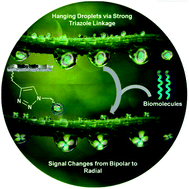Brownian motion retarded polymer-encapsulated liquid crystal droplets anchored over a patterned substrate via click chemistry†
Abstract
Highly sensitive liquid crystalline (LC) materials are promising candidates for sensing applications. Anchoring of liquid crystal (LC) droplets over substrates can reduce the signal broadening due to retarded Brownian motion. In addition, anchoring over patterned substrates can facilitate the precise quantification of spatially resolved detection of analyte. To this end, we report a versatile approach to anchor LC droplets encapsulated within polymer capsules over a patterned substrate via a highly stable triazole linkage created through click chemistry. Confocal and polarized microcopy images confirm the anchoring of LC droplets over the glass substrates. Change in orientation (bipolar to radial) due to the binding of sodium dodecyl sulfate (SDS) surfactant and 1,2-dilauroyl-sn-glycero-3-phosphocholine (L-DLPC) at the LC interface suggests that the sensing capabilities of the Brownian motion-retarded encapsulated LC droplets is retained. It is also demonstrated that the so assembled systems are stable over six months, which makes them potential candidates for portable microfluidic sensors.


 Please wait while we load your content...
Please wait while we load your content...